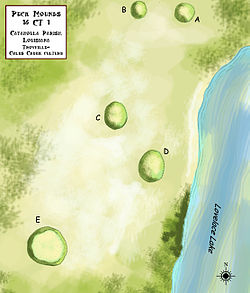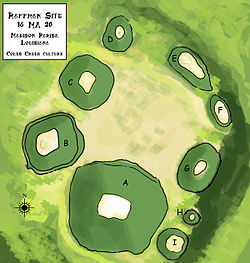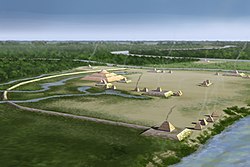| Site | Image | Description |
|---|
| Aden site | | Located in Issaquena County, Mississippi, it is the type site for the Aden Phase (800-900 CE) of the Lower Yazoo Basin Coles Creek chronology. |
| Balmoral Mounds | | A group of three mounds located in Tensas Parish, Louisiana. [8] Type site for the Balmoral Phase(1000-1100 CE) of the Tensas Basin and Natchez Bluffs Coles Creek chronology |
| Bayou Grande Cheniere Mounds |  | A large group of twelve mounds located in Plaquemines Parish, Louisiana from the Coastal Coles Creek culture. [5] |
| Crippen Point site | | Type site for the Crippen Point Phase(1050-1200 CE) of the Lower Yazoo Basin Coles Creek chronology, located in Sharkey County, Mississippi. |
| Cypress Grove Mound | | A well-preserved conical mound located in Concordia Parish, Louisiana dating from approximately 750 CE. [9] |
| DePrato Mounds | | A multimound complex located in Concordia Parish, Louisiana, radiocarbon and decorated pottery dated to about 600 CE during the Troyville/Coles Creek period. [10] |
| Feltus Mound Site | | A group of three mounds, dated to 700 to 1000 CE, clustered around a central plaza. Located north of Natchez. [11] |
| Filhiol Mound Site | | Located in Ouachita Parish, Louisiana on a natural levee of the Ouachita River [12] |
| Flowery Mound | | A single mound Late Coles Creek to Plaquemine/Mississippian site in Tensas Parish, Louisiana which dates from approximately 950–1541. [13] |
| Frogmore Mound Site |  | A Late Coles Creek site in Concordia Parish, Louisiana. [14] |
| Ghost Site Mounds | | A site in Tensas Parish, Louisiana with an Early to Middle Coles Creek component(700–1200)and a Late Coles Creek to Plaquemine component(1200 to 1541) [15] |
| Greenhouse site |  | A multimound site in Avoyelles Parish, Louisiana from the Troyville-Coles Creek Period [16] |
| Insley Mounds | | A multimound site in Richland Parish, Louisiana with a Poverty Point period component (1700–1000 BCE) and a Coles Creek component (720 to 1200 CE). [17] |
| Kings Crossing site |  | The type site for the Kings Crossing phase (900 -1050 CE), a multimound site located near Vicksburg in Warren County, Mississippi [18] |
| Lamarque Landing Mound | | A single mound site in Concordia Parish, Louisiana dating to about 1000 CE. [19] |
| Little Pecan Island Site | | An archaeological site of the Coastal Coles Creek culture, dating to 800 to 1100 CE near Grand Chenier, Louisiana in Cameron Parish. Investigations by Robert Wauchope in 1946 produced a number of flexed burials and ceramic chronologies which helped determine the age and cultural affiliation of the site. [20] |
| Marsden Mounds | | A multimound site in West Carroll Parish, Louisiana near Delhi, Louisiana, with a Poverty Point period component (1500 BCE) and a Coles Creek component (400 to 1200 CE). [21] |
| Mazique Archeological Site |  | A multimound site in Adams County, Mississippi southeast of Natchez, Mississippi, with components from both the Coles Creek period (700-1000 CE) and the later Plaquemine Mississippian period (1000-1680 CE), when it was recorded in historic times as the White Apple village of the Natchez people. [1] |
| Morgan Mounds | | A multimound site of the Coastal Coles Creek culture, built and occupied from 700 to 1000 CE on Pecan Island in Vermilion Parish, Louisiana. Of the 45 recorded Coastal Coles Creek sites in the Petite Anse region, it is the only one with ceremonial substructure mounds and was possibly the center of a local chiefdom. [22] |
| Mott Mounds |  | A large multimound site with components from the Late Marksville to the Plaquemine period but with its main occupation during the Coles Creek period, located in Franklin Parish, Louisiana. [23] |
| Peck Mounds |  | A multimound site from the Late Troyville-Early Coles Creek period located in Catahoula Parish, Louisiana [24] |
| Raffman site |  | A multimound site whose main period of occupation was during the Balmoral Phase(1000-1100 CE) of the Tensas Basin and Natchez Bluffs Coles Creek chronology, located in Madison Parish, Louisiana and constructed between 700 and 1000 CE [25] |
| Scott Place Mounds | | A multimound site from the Late Coles Creek-Early Plaquemine period located in Union Parish, Louisiana [26] |
| Sims site | | A multimound site located in Saint Charles Parish, Louisiana near the town of Paradis, Louisiana, first inhabited about 800 CE by peoples of the Coles Creek culture. By 1100 CE the culture of the site had transitioned into the Mississippianized Plaquemine culture that lasted until 1450 CE. A little later was a Late Mississippian/protohistic period that lasted from 1500 until about 1700 or 1800. [27] |
| Spanish Fort | | The site is a semicircular earthwork that lies along the Sunflower River nearly 10 miles (16 km) downstream from the community of Holly Bluff. [28] : 201 |
| Sundown Mounds | | A multimound site from the Early Coles Creek in Tensas Parish, Louisiana that is the type site for the Sundown Phase(700-800 CE) [29] |
| Transylvania Mounds | | A large multimound site with 2 plazas and components from the Coles Creek (700–1200) and Plaquemine/Mississippian periods (1200–1541). It located in East Carroll Parish, Louisiana [30] It is the type site for the Transylvania Phase of the Tensas Basin Plaquemine Mississippian chronology. |
| Troyville Earthworks |  | A large multimound site with components dating from 100 BCE to 700 CE. It once had the tallest mound in Louisiana at 82 feet (25 m) in height. It is located in Catahoula Parish, Louisiana in the town of Jonesville. [30] |
| Venable Mound | | A single mound site with components from the Troyville, Coles Creek and Plaquemine periods, located in Morehouse Parish, Louisiana [31] |
| Wade Landing Mound | | A single mound site located in Caldwell Parish, Louisiana [32] |
|











